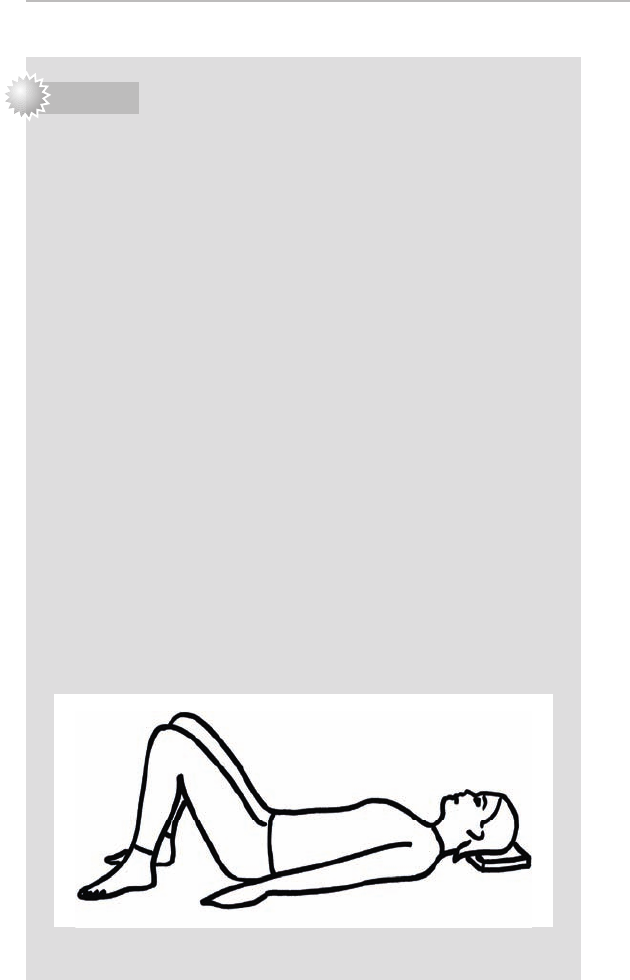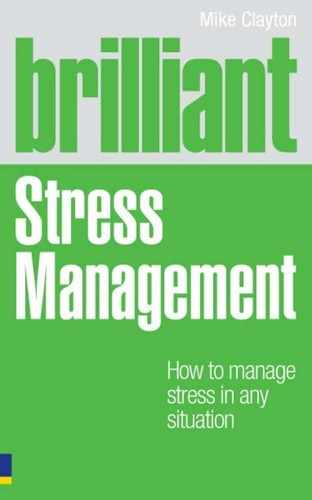
Control your physical response to stress 33
Good rest
Rest and relaxation are an essen-
tial part of dealing effectively with
stress. As we become more stressed
we nd it harder to relax and sleep
well. And, as we get less sleep, our
ability to put events into perspective
and cope with stressors diminishes. Rest and stress are part of
a feedback loop, so take control and move from a vicious cycle
into a virtuous cycle of good rest leading to resourceful attitudes,
bringing about effective actions, that allow you to relax properly
and sleep well.
brilliant
exercise
Stand up, feet about shoulder width apart, firmly on the floor
and make yourself comfortable. Allow your puppet string to draw
you up into a good posture, with your arms comfortably by your
sides.
Now let your fingers wiggle and, as they do, let your wrists start to
shake. Let the shaking increase to include your whole arms. Then let
your shoulders move too and, eventually, allow your whole body to
rise up and down, on the balls of your feet.
Now, progressively reverse this. Take all your weight on your feet
and then slow the shaking in your trunk, then your shoulders,
gradually still your arms, and then your wrists and, finally, let your
fingers come to rest.
You should notice a little tingling in the tips of your fingers. That
is the sensation of oxygenated blood flowing. If it’s flowing in your
fingers, then it is also flowing into your head and giving your brain
a good boost of oxygen.
rest and relaxation are
an essential part of
dealing effectively with
stress
34 brilliant stress management
Relaxing
Relaxation triggers a physiological response that is the opposite
to the stress response. Now your sympathetic nervous system
will reduce its activity, slowing your breathing and heart rates,
while your parasympathetic nervous system takes control, re-
activating your immune response, your digestive system and
your natural sleep cycles. Your sex drive will surely follow.
If only you could then boost your relaxation and create a
powerful sense of wellbeing. Perhaps incredibly powerful drugs
might help. Drugs that are legal and completely safe to use
would be ideal – and better still, free.
The drugs we are talking about are a group of natural brain
chemicals called endorphins, which are responsible, wholly or in
part, for senses of elation, relaxation, and pain relief. Our hypo-
thalamus and pituitary glands (which also play a big part in our
ght-or-ight response – see Chapter 1) produce them naturally
at times when we exercise hard, feel love or excitement, eat spicy
food, and have an orgasm.
You can also fool your brain into releasing endorphins by
allowing yourself to think about a pleasurable memory in great
detail. Take about 10 minutes to close your eyes and wallow in
that memory, seeing the scenes you saw, hearing the sounds,
smelling the smells and feeling the textures and temperature.
Make it as real as you can and feel free to amplify how good it
was in your memory. You can use this technique to conjure up
a sense of calm, happiness, joy or anything else. Build a library
of recollections or even fantasies that you can call on when you
need them.
The perfect relaxing posture
We met the Alexander Technique earlier in this chapter, with
some tips for standing up and sitting down. To relax completely,
try lying down the Alexander way.

Control your physical response to stress 35
brilliant
exercise
The Alexander semi-supine posture
Find a comfortable place on a firm floor – ideally on a carpet or
exercise mat. You will need a couple of books to rest your head –
approximately 5 cm thick, but take time to find the right height for
you.
Lie with your bottom, back and shoulders on the floor and your
head resting on your books. If you feel pressure on your chin or
throat, try a smaller pile of books and, if you feel your head tilted
back, try more. Bend your legs and bring your feet up, just in front
of your bottom, about shoulder width apart, with your feet flat on
the floor and your knees pointing upwards. Rest your hands gently
on your tummy or flat on the floor beside you. Breathe steadily
from deep down.
Try resting in this posture for 10 to 20 minutes – maybe combining
it with a gentle meditation. Imagining yourself to be made of
chocolate on a warm day works well. As you do this, feel your body
melting and spreading over the floor. This will encourage your
muscles to relax and your joints to lengthen and widen.
© MikeClayton,2011
Figure 2.1 The Alexander semi-supine posture
36 brilliant stress management
Other routes to deep relaxation
Mankind has found a host of ways you can relax deeply, which in
itself indicates how important it is to us. Here are some brilliant
options. Some of them will not be for you, and may seem far out
or ineffective. What matters is that you can nd one or two that
do work for you.
Aromatherapy
Body massage
Indian head massage
Reiki healing
Reexology
Listening to music
Performing music
Reading
Taking a bath
Sitting contemplating the world
Daydreaming
Taking a nap
Watching a movie
Listening to the radio
Meditating
Meditation has a long and glorious history, with modern science
only now starting to gure out why it is so valuable to us. A
New Scientist review article published in January 2011 identi-
ed 17 benets that have been measured in scientic studies,
in the areas of behaviour, thinking, emotions and health. Of
particular interest to you in controlling your stress are: reducing
anxiety, combating stress, reducing emotional reactivity, helping
with eating disorders, reducing depression and sustaining
concentration.

Control your physical response to stress 37
brilliant
exercise
Meditation
Find a comfortable upright chair somewhere where you will not be
disturbed, and sit down in a good posture. Place your hands in your
lap, left hand on top of right (unless you are left-handed). Gently
close your eyes.
As you relax, you will start to gently focus your attention on one
thing. Some people prefer a word, or mantra. In traditional Indian
techniques, this may be a Sanskrit word, but you can choose any
word or phrase, although something abstract will work best. You
could focus on an image and, again, something abstract like a
simple shape will work well. Another common approach is to
focus on your breathing and, in Ki meditation, practitioners focus
on a point in the centre of their abdomen, called the Hara in
Japanese, Dantian in Chinese and known as your ‘one-point’ in
English.
So, focus on the object of your meditation; I will use the word ‘calm’
in this example, and allow yourself to repeat it whenever it comes
into your mind. Your thoughts will stray: that’s natural. As soon
as you notice that you are no longer focused on the word ‘calm’,
then let go of the unwanted thoughts and bring your mind back
to ‘calm’. As you sit, your mind will gently settle. The unwanted
thoughts will return, but simply push them gently away and return
to ‘calm’.
When you start, 10 minutes will seem like a long time. But
gradually build up your practice to 20 minutes to get the full
benefit. Meditation works best when it is regular, every day at the
same time. To get the most from it, 20 minutes in the morning and
then again in the evening will truly relax you and sharpen your
ability to concentrate.
..................Content has been hidden....................
You can't read the all page of ebook, please click here login for view all page.
